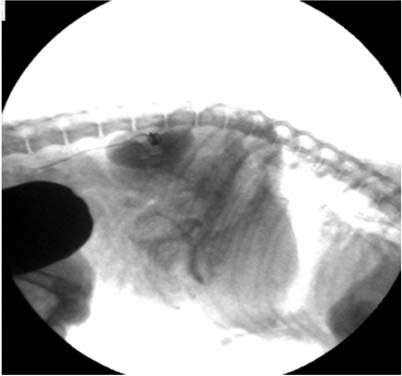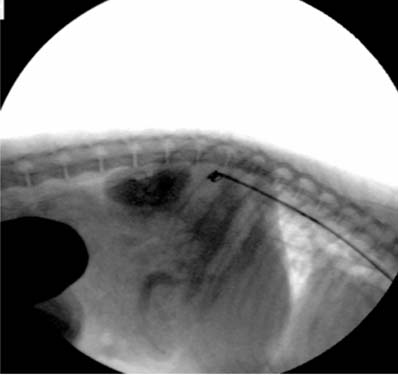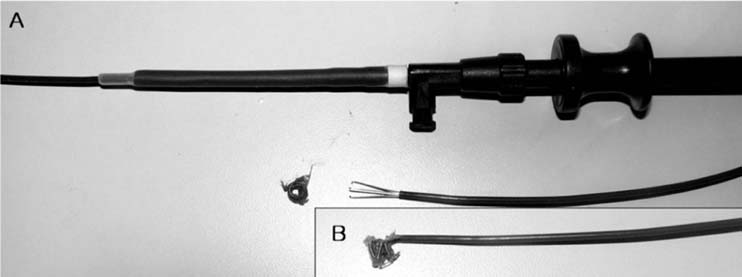J Vet Sci.
2007 Jun;8(2):205-207. 10.4142/jvs.2007.8.2.205.
Retrieval of an embolization coil accidentally dislodged in the descending aorta of a dog with a patent ductus arteriosus
- Affiliations
-
- 1Section of Small Animal Internal Medicine, School of Veterinary Medicine, Kangwon National University, Chuncheon 200-701, Korea. hyun5188@kangwon.ac.kr
- KMID: 1089676
- DOI: http://doi.org/10.4142/jvs.2007.8.2.205
Abstract
- A 3.5-year-old intact female miniature poodle (weighing 2.7 kg) was referred to the Veterinary Teaching Hospital at Kangwon National University, because of inadvertent aortic embolization, by an occlusion coil used for the closure of patent ductus arteriosus (PDA). The coil was found at the site of the branching renal arteries in the abdominal aorta. A foreign body forceps with a three-wire nail tip was used, with fluoroscopic guidance, to retrieve the coil. After the removal, the dog was treated with heparin to prevent thromboembolization.
MeSH Terms
Figure
Reference
-
1. Edwards RD, Taylor A, Robertson IR. Case report: percutaneous retrieval of a misplaced embolization coil. Clin Radiol. 1993. 48:143–144.
Article2. Fox PR, Bond BR, Sommer RJ. Nonsurgical transcatheter coil occlusion of patent ductus arteriosus in two dogs using a preformed nitinol snare delivery technique. J Vet Intern Med. 1998. 12:182–185.
Article3. Grifka RG, Miller MW, Frischmeyer KJ, Mullins CE. Transcatheter occlusion of a patent ductus arteriosus in a Newfoundland puppy using the Gianturco-Grifka vascular occlusion device. J Vet Intern Med. 1996. 10:42–44.
Article4. Hwang MS, Su WJ. Iatrogenic cardiovocal syndrome caused by transcatheter coil closure of patent ductus arteriosus. Acta Paediatr. 2005. 94:372–374.
Article5. Kuo HC, Ko SF, Wu YT, Huang CF, Chien SJ, Tiao MM, Liang CD. Obstruction of the aorta and left pulmonary artery after Gianturco coil occlusion of patent ductus arteriosus. Cardiovasc Intervent Radiol. 2005. 28:124–126.
Article6. Gordon SG, Miller MW. Transarterial coil embolization for canine patent ductus arteriosus occlusion. Clin Tech Small Anim Pract. 2005. 20:196–202.
Article7. Oyama MA, Sisson DD, Thomas WP, Bonagura JD. Ettinger SJ, Feldman EC, editors. Congenital heart disease. Textbook of Veterinary Internal Medicine. 2005. 6th ed. Philadelphia: Saunders;972–1021.8. Patterson DF, Detweiler DK. Hereditary transmission of patent ductus arteriosus in the dog. Am Heart J. 1967. 74:289–290.
Article9. Schneider M, Hildebrandt N, Schweigl T, Schneider I, Hagel KH, Neu H. Transvenous embolization of small patent ductus arteriosus with single detachable coils in dogs. J Vet Intern Med. 2001. 15:222–228.
Article10. Snaps FR, Mc Entee K, Saunders JH, Dondelinger RF. Treatment of patent ductus arteriosus by placement of intravascular coils in a pup. J Am Vet Med Assoc. 1995. 207:724–725.11. Stokhof AA, Sreeram N, Wolvekamp WT. Transcatheter closure of patent ductus arteriosus using occluding spring coils. J Vet Intern Med. 2000. 14:452–455.
Article
- Full Text Links
- Actions
-
Cited
- CITED
-
- Close
- Share
- Similar articles
-
- Three Cases of Hemolysis After Transcatheter Closure of A Patent Ductus Arteriosus
- Nonsurgical closure of patent ductus arteriosus with the rashkind PDA occluder system
- Percutaneous Forceps Retrieval of an Embolized Amplatzer Duct Occluder
- A rare case of intramural patent ductus arteriosus in a dog: anatomic, histopathologic, and radiographic features
- Complete interruption of the aortic arch




